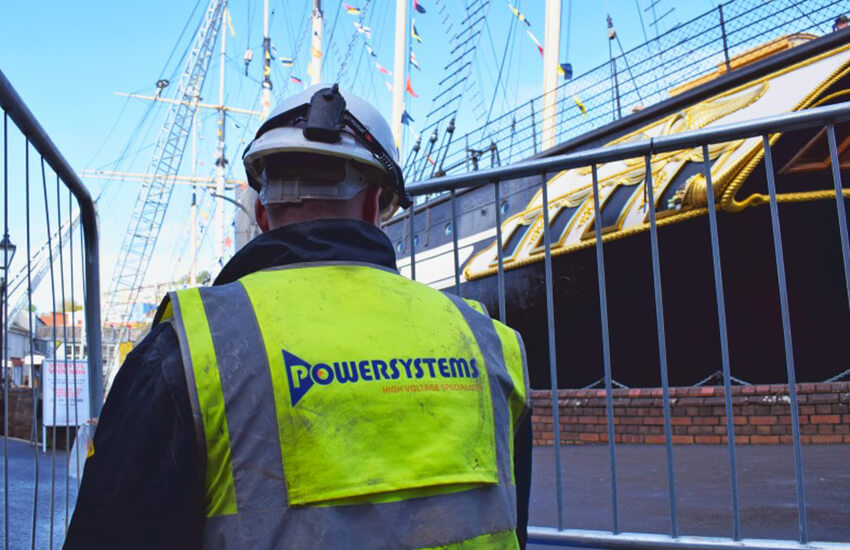Powersystems have been appointed as the main LV supplies for the new SS Great Britain museum and visitor centre.
SS Great Britain Museum and Visitor Centre
Powersystems expertise has been called upon to undertake main LV supplies for the new SS Great Britain museum and visitor centre. The SS Great Britain is an iconic landmark of Bristol’s harbourside and was the worlds first iron built steamship to cross the Atlantic Ocean, built in the dock where it stands today, constructed by Isambard Kingdom Brunel.
Powersystems Cable and Installation Work
Powersystems are about diversification and when not carrying out grid and infrastructure works for major UK and energy projects, we are often called upon to apply specialist skills and knowledge to carry out challenging cable and switchgear installation work.
Brunel’s SS Great Britain
Brunel’s SS Great Britain is one of the most important historic ships in the world. When she was launched in 1843 she was called ‘the greatest experiment since the Creation’. By combining size, power and innovative technology, Brunel created a ship that changed history. His vision for the SS Great Britain made her the great-great-grandmother for all modern ships.
SS Great Britain
SS Great Britain is a museum ship and former passenger steamship, which was advanced for her time. She was the longest passenger ship in the world from 1845 to 1854. She was designed by Isambard Kingdom Brunel (1806–1859), for the Great Western Steamship Company‘s transatlantic service between Bristol and New York. While other ships had been built of iron or equipped with a screw propeller, the Great Britain was the first to combine these features in a large ocean-going ship. She was the first iron steamer to cross the Atlantic, which she did in 1845, in the time of 14 days.
The ship is 322 ft (98 m) in length and has a 3,400-ton displacement. She was powered by two inclined 2 cylinder engines of the direct-acting type, with twin 88 in (220 cm) bore, 6-foot (1.8 m) stroke cylinders. She was also provided with secondary masts for sail power. The four decks provided accommodation for a crew of 120, plus 360 passengers who were provided with cabins, and dining and promenade saloons.
When launched in 1843, SS Great Britain was by far the largest vessel afloat. But her protracted construction time of six years (1839-1845) and high cost had left her owners in a difficult financial position, and they were forced out of business in 1846, having spent all their remaining funds refloating the ship after she ran aground at Dundrum Bay in County Down near Newcastle in what is now Northern Ireland, after a navigation error. In 1852 she was sold for salvage and repaired. SS Great Britain later carried thousands of immigrants to Australia from 1852 until being converted to all-sail in 1881. Three years later, she was retired to the Falkland Islands, where she was used as a warehouse, quarantine ship and coal hulk until she was scuttled and sunk in 1937, 98 years since being laid down at the start of her construction.
In 1970, after SS Great Britain had lain under water and abandoned for 33 years half a world away, Sir Jack Arnold Hayward, OBE (1923-2015) paid for the vessel to be raised and repaired enough to be towed north through the Atlantic back to the United Kingdom, and returned to the Bristol dry dock where she had been built 127 years earlier. Hayward was a prominent businessman, developer, philanthropist and owner of the English football club Wolverhampton Wanderers.
Now listed as part of the National Historic Fleet, the SS Great Britain is a visitor attraction and museum ship in Bristol Harbour, with between 150,000 and 200,000 visitors annually.
Notes to Editors:
Contact Information:
- This article is written by Jules Daly, Marketing and Communications Manager at Powersystems UK.
- Email jules.daly@powersystemsuk.com Telephone 01454 318000
- Photography Copyright please credit all images used to powersystemsuk.co.uk
Powersystems are powering the transition to a carbon free future
As a high voltage specialist electrical engineering company with over 45 years (1977-2022) experience Powersystems have grown by reputation to become a trusted force in the design, installation and commissioning of electrical infrastructure across the UK.
Celebrating 25 years as the first Lloyds National Electricity Registration Scheme ‘s accredited Independent Connection Provider (ICP), Powersystems are capable of delivering contestable grid connections at voltages up to 132 kV.
Since 2000, Powersystems have connected over 6 Gigawatts of renewable energy generation to the UK electricity grid, along with decarbonisation technology which includes; wind energy projects, solar, anaerobic digestion, hydroelectric, electrical vehicle infrastructure, short term operating reserve STOR, combined heat and power (CHP), Grid stability projects like rotating stabilisers, and battery energy storage systems (BESS) as well as commercial industrial private wire networks.
Working with partners, delivering sustainable power solutions, proudly the Powersystems high voltage specialist team have connected 27% of all U.K. onshore wind farm
At the core of the operation is a commitment to the highest values of health and safety, welfare, quality and the environment. Powersystems Integrated management systems are ISO accredited and their approach under their health and safety ‘Priority No.1’ brand is to aim for the best industry practice in all.
Powersystems UK Ltd. is an Employee-Owned Business and as such has a keen interest in the well-being of all its employees. They encourage and empower you to be imaginative, share great ideas and be involved in the success of the business.
Speak to Powersystems today
You can contact us as follows

